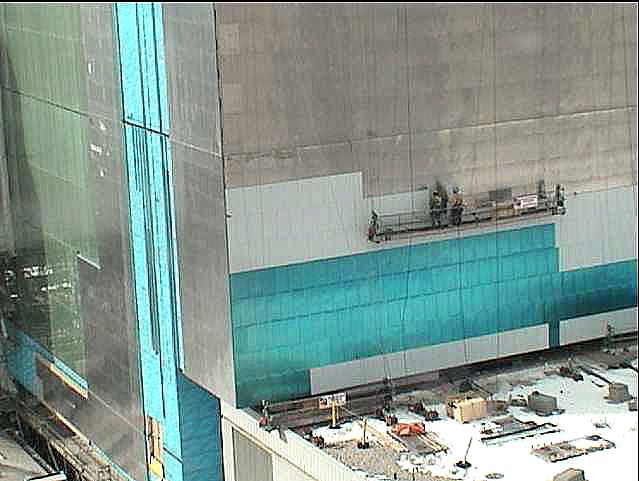Hey, it's been done--and I think, now, destroyed as well--at JFK Airport
I know, OT, but as I referenced it earlier in this thread...
Landmark JFK Stained Glass Coming Down
By AMY WESTFELDT – 1 day ago
NEW YORK (AP) — Its red, sapphire and purple stained-glass panels have greeted millions of air travelers arriving at and departing New York since 1960.
Now, the panels are the ones on the move.
American Airlines last week quietly began dismantling the 900-pane window facade at an old John F. Kennedy International Airport terminal, despite pleas to keep the piece intact.
Many museums said the work — more than 300 feet long and 23 feet high — was too large to handle. The airline said removing it in one piece, transporting it and storing it would cost millions.
"It's not necessarily the outcome that everyone might have hoped for," airline spokesman Tim Smith said Wednesday. "But any solutions were extraordinarily expensive and no one would be able to do that."
Smith said small pieces of the window would become displays at Kennedy Airport, the airline's Fort Worth, Texas, headquarters, and a Long Island museum. The rest is being given to an antique salvage company that is taking down the glass for free.
Artist Robert Sowers created the modern glass facade for American's terminal when it opened in 1960 at Kennedy, then known as Idlewild Airport. It was believed to be the world's largest stained-glass window.
An artist who said he studied with the window's designer criticized its removal, saying the airline was too cheap to properly restore a priceless work of art.
"That was American Airlines' visual identity at Kennedy for 50 years. To just throw it in a trash heap is incredibly disrespectful," said Kenneth vonRoenn, an architect and glass artist in Louisville, Ky. "To intentionally destroy it because it was more cost effective ... it's regrettable."
The airline announced plans more than a decade ago to build a new, larger terminal at Kennedy. The $1.3 billion facility opened last summer after years of discussion of what to do with the window. A proposal to scrap the glass and convert pieces of it into employee key chains was instantly derided and fell through.
Eileen Clifford, a 29-year American flight attendant from West Islip, said the window was a beacon for her. She called dozens of conservation groups, asking museums such as the Smithsonian to preserve and display it.
"It's too big," she said they told her. She said the Cradle of Aviation museum in Garden City had agreed to take it, but a museum official said it might only be able to use a small part of the window.
Smith, the airline spokesman, said no group came forward with an offer to display the window in its entirety.
American Airlines needs to work fast to take down the terminal the facade is attached to and use the empty space to store ground equipment such as snowplows and de-icing machines. The airline spends around $50,000 a day in construction costs as long as the building stands.
The company removing the glass panels has already taken down about 10 percent of the panels and hopes to have the entire window dismantled in three weeks, Smith said. The airline will then select which pieces — about 2 feet by 4 feet — it would like to use for the three separate displays.
VonRoenn said the company doesn't specialize in removing stained glass and would likely damage the surviving pieces. Furthermore, he said, small displays of the window panels "won't visually make any sense." Sowers, who died in 1990, wouldn't want it, he said.
"Just destroy it," vonRoenn said. "He would rather have not any part of it seen than to have it portioned off."
On the Net:
Rescue group:
http://saveamericaswindow.org
http://www.nytimes.com/2008/02/22/nyregion/22window.html?ref=nyregion
A Window That Reflected a Golden Age Comes Down at Kennedy Airport
By KEN BELSON
Published: February 22, 2008
Back when Kennedy International Airport was called Idlewild and the jet age was just blooming, airports were considered elegant, even majestic destinations.
That is why Ken Lonsinger, a flight attendant, wandered onto an empty terrace at Kennedy to snap photographs of American Airlines’ vacant Terminal 8 and its stained-glass window.
From there he could overlook the 48-year-old terminal, which is being torn down to make room for snowplows and other equipment. It was replaced last year by a $1.3 billion towering steel-and-glass substitute next door. The demolition, which started last fall, has left girders exposed and scrap metal piled high.
For the past week and a half, salvage workers on cranes have been carefully popping some of the more than 900 stained-glass panes out of their frames, which together stretch 317 feet long and 23 feet wide.
It is a somber end for what was once an iconic building in the airline industry and the art world, with its interior murals and stained glass exterior. The building, along with Eero Saarinen’s landmark Trans World Airlines terminal nearby, was part of a pavilion that at once spoke to New York’s commercial might and its aesthetic sensibilities. It was completed in 1960 at a cost of $14 million.
Mr. Lonsinger, 52, who joined American Airlines in 1989, came along too late to fully appreciate the airport in that era. But as a New York-based flight attendant who worked for years in Terminal 8, he loved the way the red, sapphire and white stained glass radiated light into the building during the day and how it was illuminated at night.
“I had to take pictures of it in case it was gone before I got back,†said Mr. Lonsinger, who was leaving for a weeklong vacation in Norway. “It still looks kind of modern to me, and you can’t get that these days.â€
Mr. Lonsinger and other employees acknowledged that at a time when airlines were losing billions of dollars and cutting thousands of jobs, saving a stained-glass window the length of a football field might seem extravagant. Art experts estimated that it would cost at least $1 million to remove it intact, and even more to restore it and install the glass elsewhere. American Airlines said it was already spending $50,000 a day to demolish the building.
Some of the panes, which are four feet long and up to four feet high, may be taken to the Cradle of Aviation Museum in Garden City on Long Island. Others will be shipped to a museum in Fort Worth, where American Airlines has its headquarters. The company said that other panes might be incorporated into parts of the new terminal, and the remainder would be hauled away by a nonprofit group that planned to restore and sell them.
“We worked hard to find anyone who could take it in its entirety,†said Tim Smith, a spokesman for the airline. “It wasn’t the end result we hoped for, but we really tried to remember it.â€
Some at American say that not enough was done to save the stained glass. Eileen Vaquilar Clifford, a longtime flight attendant who lives in West Islip, started Save America’s Window, a nonprofit group that submitted plans more than a year ago to have the entire window become part of a facade of a building on Long Island. But Ms. Clifford’s group was unable to raise enough money, she said, partly because the airline kept delaying the demolition.
“Everyone goes to Europe to see these old things, but it’s a shame we don’t give more thought to saving things that have contributed to our own history and culture,†said Ms. Clifford, who has worked for American Airlines in New York for 29 years. “It’s a symbol of grandeur and New York City, and it’s an icon to me.â€
The artist Robert Sowers, who designed the window, was one of the first to incorporate stained glass so prominently in a secular building, a style that was later widely imitated.
In the art world, some question whether the window — said to be the largest stained-glass window in the world when it was installed — will still have meaning when it is no longer in one piece.
But some say that breaking it into 40-foot-by-40-foot sections, for example, might re-create a touch of its splendor, but only if it is placed in such a way that it makes the most of the light.
“The problem is the size of the piece is what makes it so special,†said Martin Rambusch, a specialist in the medium whose grandfather worked on the design and fabrication of the stained glass. “If you could save 100 square feet, it sounds like a big thing. But it’s very difficult to try and figure out where to place it to get the full movement and coloration.â€
In truth, Mr. Rambusch said, the window has been losing its luster for years. In the 1970s, a protective glaze was added, something he likened to an old Victorian home with thick heat-saver windows. And over the years, offices were added in the building, blocking views of the window from the inside.
Then, as the airline’s finances suffered in the aftermath of the terrorist attack on Sept. 11, 2001, maintenance at the terminal suffered, he said.
Increasingly, visitors to the terminal gave the window little notice.
David Dillahunty, 48, an executive in the toy industry, passes through the terminal every few months on business trips from California. He is sympathetic to those who want to preserve the stained glass, just as he supports efforts to save two former blimp hangars in Orange County, Calif.
But “as a traveler from another area, you don’take the time to look,†said Mr. Dillahunty, who was waiting for his flight in the new terminal. “You just motor through.â€









